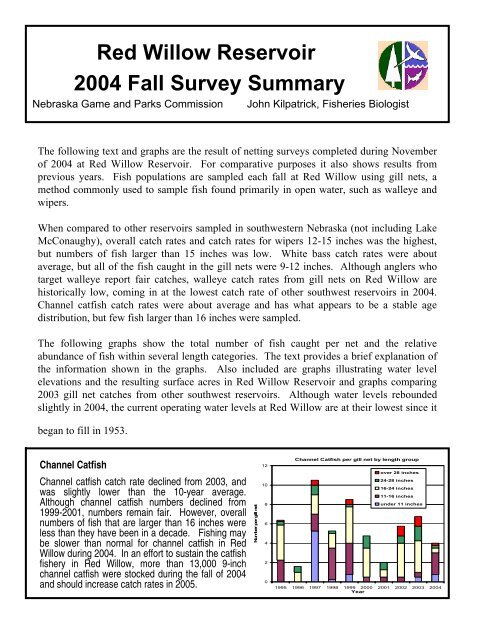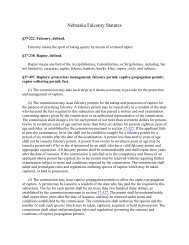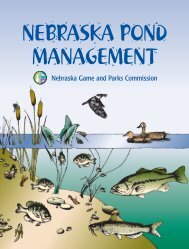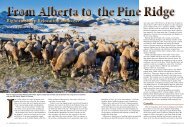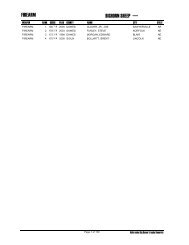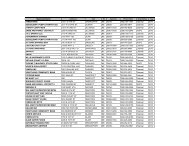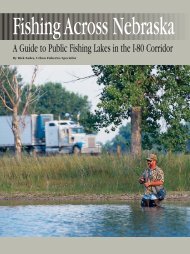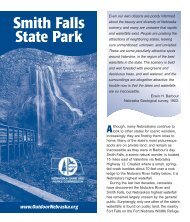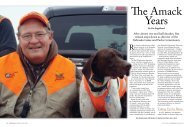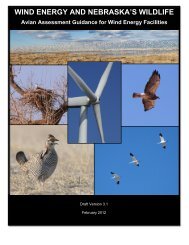Red Willow Reservoir 2004 Fall Survey Summary - Nebraska Game ...
Red Willow Reservoir 2004 Fall Survey Summary - Nebraska Game ...
Red Willow Reservoir 2004 Fall Survey Summary - Nebraska Game ...
Create successful ePaper yourself
Turn your PDF publications into a flip-book with our unique Google optimized e-Paper software.
<strong>Red</strong> <strong>Willow</strong> <strong>Reservoir</strong><strong>2004</strong> <strong>Fall</strong> <strong>Survey</strong> <strong>Summary</strong><strong>Nebraska</strong> <strong>Game</strong> and Parks Commission John Kilpatrick, Fisheries BiologistThe following text and graphs are the result of netting surveys completed during Novemberof <strong>2004</strong> at <strong>Red</strong> <strong>Willow</strong> <strong>Reservoir</strong>. For comparative purposes it also shows results fromprevious years. Fish populations are sampled each fall at <strong>Red</strong> <strong>Willow</strong> using gill nets, amethod commonly used to sample fish found primarily in open water, such as walleye andwipers.When compared to other reservoirs sampled in southwestern <strong>Nebraska</strong> (not including LakeMcConaughy), overall catch rates and catch rates for wipers 12-15 inches was the highest,but numbers of fish larger than 15 inches was low. White bass catch rates were aboutaverage, but all of the fish caught in the gill nets were 9-12 inches. Although anglers whotarget walleye report fair catches, walleye catch rates from gill nets on <strong>Red</strong> <strong>Willow</strong> arehistorically low, coming in at the lowest catch rate of other southwest reservoirs in <strong>2004</strong>.Channel catfish catch rates were about average and has what appears to be a stable agedistribution, but few fish larger than 16 inches were sampled.The following graphs show the total number of fish caught per net and the relativeabundance of fish within several length categories. The text provides a brief explanation ofthe information shown in the graphs. Also included are graphs illustrating water levelelevations and the resulting surface acres in <strong>Red</strong> <strong>Willow</strong> <strong>Reservoir</strong> and graphs comparing2003 gill net catches from other southwest reservoirs. Although water levels reboundedslightly in <strong>2004</strong>, the current operating water levels at <strong>Red</strong> <strong>Willow</strong> are at their lowest since itbegan to fill in 1953.Channel CatfishChannel catfish catch rate declined from 2003, andwas slightly lower than the 10-year average.Although channel catfish numbers declined from1999-2001, numbers remain fair. However, overallnumbers of fish that are larger than 16 inches wereless than they have been in a decade. Fishing maybe slower than normal for channel catfish in <strong>Red</strong><strong>Willow</strong> during <strong>2004</strong>. In an effort to sustain the catfishfishery in <strong>Red</strong> <strong>Willow</strong>, more than 13,000 9-inchchannel catfish were stocked during the fall of <strong>2004</strong>and should increase catch rates in 2005.Number per gill net121086420Channel Catfish per gill net by length groupover 28 inches24-28 inches16-24 inches11-16 inchesunder 11 inches1995 1996 1997 1998 1999 2000 2001 2002 2003 <strong>2004</strong>Year
WalleyeAlthough numbers of walleye sampled during the<strong>2004</strong> gill net sample were about 1/3 less than the2003 sample, there has been an overall increasingtrend in walleye catch rates from the 1997 sample.Numbers of harvestable-sized walleyes (> 15”) arefair and sampled at the highest level since 2000.Despite the paucity of larger fish in our sample,seven master angler walleye were reported from<strong>Red</strong> <strong>Willow</strong> in 2003. Fishing for walleye should besimilar to past years, but catch rates for legal-sizedwalleye may be slightly higher. About 1 millionwalleye fry will be stocked into <strong>Red</strong> <strong>Willow</strong> duringJune of 2005.Number per gill net6543210Walleye per gill net by length groupover 25 inches20-25 inches15-20 inches10-15 inchesunder 10 inches1995 1996 1997 1998 1999 2000 2001 2002 2003 <strong>2004</strong>YearWhite BassAfter a record gill net catch in 2003, white bassnumbers were cut down by more than half.However, white bass numbers remain fair and catchrates for fish over 9 inches is the second highest thatit has been in a decade. The average white basssampled was 10.4 inches and weighed in at a littleunder a half pound. For those wishing to catch andrelease wipers, white bass will provide a harvestablefish with fair catch rates. Angling should be fair forwhite bass this year, although few fish over 12inches will likely be caught. Only one master anglerwhite bass (>17” or > 21/2 pounds) was reported in2003, but it was the first reported since 1999.Number per gill net181614121086420White bass per gill net by length groupover 15 inches12-15 inches9-12 inches6-9 inchesunder 6 inches1995 1996 1997 1998 1999 2000 2001 2002 2003 <strong>2004</strong>YearWipersAlthough overall <strong>2004</strong> wiper numbers were abouthalf that of 2003, they were still more than triple thatof 1995-2002 samples. For only the second time ina decade, no fish larger than 20 inches weresampled, but numbers of fish larger than 12 incheswere the second highest in a decade. As in 2003,there was a significant algae bloom in <strong>2004</strong>, whichcontributes to poor water clarity and low dissolvedoxygen in the water. Degraded water quality in 2003and <strong>2004</strong> likely contributed to the the sampledwipers being relatively skinny for their size. A smallscalefish kill in 2003 was apparently concentratedon the larger wipers and it will take several years toproduce large numbers of master angler (> 24” or 8lbs.) fish again. Fishing should be good for wipers in2005, but numbers of master angler fish will likely belower than in years past. Wiper fingerlings will bestocked in June of 2005 into <strong>Red</strong> <strong>Willow</strong>.Number per gill net454035302520151050Wipers per gill net by length groupover 20 inches15-20 inches12-15 inches8-12 inchesunder 8 inches1995 1996 1997 1998 1999 2000 2001 2002 2003 <strong>2004</strong>Year
<strong>2004</strong> Channel Catfish Gill Net Catch Comparison Between Southwest <strong>Reservoir</strong>sSwansonSutherland<strong>Red</strong> <strong>Willow</strong>Medicine CreekMaloneyunder 11 inches11-16 inches16-24 inches24-28 inchesover 28 inchesJeffreyEnders0 5 10 15 20Channel Catfish Per Gill Net<strong>2004</strong> Walleye Gill Net Catch Comparison Between Southwest <strong>Reservoir</strong>sSwansonSutherland<strong>Red</strong> <strong>Willow</strong>Medicine CreekMaloneyunder 10 inches10-15 inches15-20 inches20-25 inchesover 25 inchesJeffreyEnders0 5 10 15 20 25 30Walleye per gillnet
<strong>2004</strong> White Bass Gill Net Catch Comparison Between Southwest <strong>Reservoir</strong>sSwansonSutherland<strong>Red</strong> <strong>Willow</strong>under 6 inches6-9 inches9-12 inches12-15 inchesover 15 inchesMedicine CreekMaloneyJeffreyEnders0 5 10 15 20 25White Bass Per Gill Net<strong>2004</strong> Hybrid Striped Bass Gill Net Catch Comparison Between Southwest <strong>Reservoir</strong>sSwansonSutherland<strong>Red</strong> <strong>Willow</strong>Medicine CreekMaloneyJeffreyEndersunder 8 inches8-12 inches12-15 inches15-20 inchesover 20 inches0 5 10 15 20Wipers per gillnetFor additional information on fisheries management at <strong>Red</strong> <strong>Willow</strong> <strong>Reservoir</strong> contact:Darrol Eichner, District Mgr. 308-284-8803, deichner@ngpc.state.ne.usSteve Brezenski, Biologist 308-535-8025, brezen@ngpc.state.ne.usJohn Kilpatrick, Biologist 308-535-8025, jkilpatrick@ngpc.state.ne.usMark Staab, Conservation Technician 308-535-8025, mstaab@ngpc.state.ne.us


